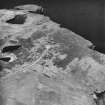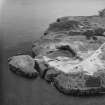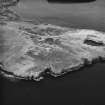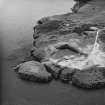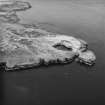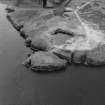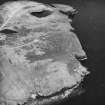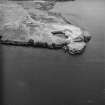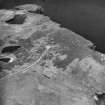Flotta, Stanger Head
Coastal Battery (Second World War), Coastal Battery(S) (First World War)
Site Name Flotta, Stanger Head
Classification Coastal Battery (Second World War), Coastal Battery(S) (First World War)
Alternative Name(s) World War I And World War Ii
Canmore ID 81743
Site Number ND39SE 11
NGR ND 3777 9259
Datum OSGB36 - NGR
Permalink http://canmore.org.uk/site/81743
- Council Orkney Islands
- Parish Walls And Flotta
- Former Region Orkney Islands Area
- Former District Orkney
- Former County Orkney
The final decision to make Scapa Flow the main base for the Grand Fleet in the event of war (over the Invergordon dockyard in the Firth of Cromarty) was made only on the eve of war. As a consequence, in August 1914, the anchorage was undefended. It was only in mid-1915 that the anchorage was secured by guns, anti-submarine booms and blockships. In the end there were 13 batteries around the approaches to Scapa Flow.
The southern entrance to Scapa Flow was the main one, and the busiest. The main defences flanked Hoxa Sound. On Stanger Head, on the island of Flotta, there were two batteries of guns. One mounted two 6-inch breech-loading guns, intended to engage medium-sized enemy ships. The other was equipped with four Quick Firing guns to engage smaller, faster vessels. In the early days of the war these were temporarily-emplaced 12-pdr guns, but these were replaced by 4-inch guns in 1915.
Stanger Head was also the location of the Fire Control Post for the Southern Fire Command, co-ordinating the fire of all the batteries protecting the southern approach to Scapa Flow.
Nothing of the 6-inch battery has survived modern quarrying, but some of the 4-inch battery survives.
This tactically important battery position was re-used in the Second World War.
Information from HS/RCAHMS World War One Audit Project (GJB) 24 September 2013.
ND39SE 11.00 3777 9259
ND39SE 11.01 ND 376 925 Radar site
ND39SE 11.02 c.ND 3762 9246 Coast Battery (WW I)
ND39SE 11.03 c.ND 3777 9258 Coast Battery (WW I)
ND39SE 11.04 c.ND 3773 9254 Coast Battery (WW II); Observation post
ND39SE 11.05 ND 37549 92404, 37692 92354 and 37812 92593 Searchlight Battery
ND39SE 11.06 centred ND 3765 9250 Military camp; Engine houses
ND39SE 11.07 c.ND 3777 9259 Coast Battery (WW II)
Used in the defence of Scapa Flow in both world wars. Consisted on a 6" and 12 pound Battery in the 1st World War, with 2 Twin 6" Batteries being constructed during World War 2. The 6" batteries are now mostly destroyed by a quarry.
J R E Hamilton 1979.
Stanger Battery: This pre World War Two Battery consisted of one 4.7 inch gun emplacement. The gun was removed in 1940 and taken to Innan Neb Battery (ND39SW 41.01).
Stanger Head Battery: A pre-World War Two Battery of 2-6 inch guns. During World War One the battery consisted of two 4 inch and two 6 inch guns. The battery was placed on a care and maintainance basis in 1945.
The military installations at Stanger Head are visible on vertical air photogrpahs ((CPE/Scot/UK 188, 4159-4160, flown 10 Ocotber 1946).
J Guy 1993; NMRS MS 810/2; WO/192/262.
ND 374 923 Stanger Battery: WWII earthworks and
ND 378 927 structural footings.
Sponsors: Historic Scoland, Orkney Archaeological Trust.
G Wilson and H Moore 1997.
Only some elements of the World War I and World War II coast batteries survive at Stanger Head. Post World War II quarrying has removed the accommodation camp and most of the gun-emplacements, engine rooms, battery observation posts and accommodation huts.
Surviving remains include the First World War 4-inch emplacements (ND39SE 11.03) with part of the magazine, part of the World War II 4-inch emplacement (ND39SE 11.07), part of the later Battery Observation tower and one 4.7-inch holdfast from World War II (ND39SE 11.04). In addition, three searchlight platforms (ND39SE 11.05) are extant immediately above the cliffs around Stanger Head. One holdfast, which had been extracted from the ground was found in an area to the N of the quarry.
Nothing of the other elements of the World War I and II coast batteries could be found in the area of the quarry.
The World War I and II coast battery is documented in the Public Record Office, and during the Second War, the battery was manned in 1941 by 533 Regiment and designated 133 Battery (WO 1992627) and WO 199/262).
Visited by RCAHMS (DE, GS), August1999
Field Visit (1997)
Elements located
Stanger Battery came into being at the outbreak of WWI to guard Hoxa Sound. Initially, the battery was armed with four temporarily emplaced twelve-pounder guns. Later, these were replaced with four 4” quick fire guns in permanent concrete emplacements. In 1915 two 6” quick fire guns were added.
In 1938, in preparation for the war, the Stanger Battery was reopened with the installation of two 6” guns on temporary emplacements. By 1940, a permanent emplacement had been built and was now backed up by an additional 4.7” gun, set on a temporary emplacement nearby. This battery served to guard Hoxa and Switha Sounds.
Little survives of the batteries, due in part to extensive post-war quarrying and land disturbance. Other military remains cover an extensive area, mostly located 100m or more inland. Within the coastal zone there are frequent fragments of earthworks. These possibly represent military training areas and firing ranges. The ruinous footings of concrete and brick buildings which do survive in this area are now very obscured by vegetation.
Orkney Coastal Zone Assessment 1997.
Project (March 2013 - September 2013)
A project to characterise the quantity and quality of the Scottish resource of known surviving remains of the First World War. Carried out in partnership between Historic Scotland and RCAHMS.




















